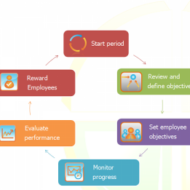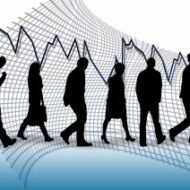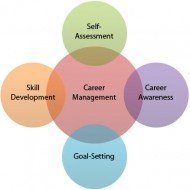Posted by Managementguru in Business Management, Principles of Management, Training & Development
on Mar 7th, 2014 | 0 comments

MBO BY PETER DRUCKER Peter Ferdinand Drucker was an influential writer, management consultant, and self-described “social ecologist. Harvard Business Review honored Drucker in the June 2004 with his seventh McKinsey Award for his article, “What Makes an Effective Executive”, the most awarded to one person. The Concept of MBO: Management by objectives was a concept introduced by the doyen of management, Peter Drucker. This concept involves formulation of objectives for the entire organization and which are then broken down into divisional, departmental and finally individual objectives. Objectives are decided on the basis of mutual consultation between managers and employees at the departmental and divisional levels and thus it can be appropriately called an integration of top down and bottom up approaches in management. The specific aim is to make the employees participate in decision making and thus motivate them to perform better. Management by objectives follows a step-by-step procedure that ensures the feasibility of the action plans decided upon. Realistic and achievable plans are set. Activities to be preformed are identified. Logical relationship between the sequences of activities is laid down. Time frame and cost frame are fixed. Resources to be allocated are decided upon. Salient features of the process: Self control and Self direction: The workers exhibit keen self control in that, they self appraise their performance that results in intrinsic motivation. Setting short goals and periodical review to match the current performance with the expected standards greatly boosts the performance of each and every individual and gives him the necessary drive to accomplish the assigned tasks. Periodic progress review: This helps to correct errors and deviations if any. This review is done by managers of higher levels in a constructive way and adequate counseling and guidance can be given to the subordinates to bridge the shortfall if any, in performance. This is possible only when there exists a mutual understanding between the superior and subordinates to find reasons and solve problems together. Reviews need not necessarily pinpoint errors but also revise future plans and actions. The major emphasis of management by objectives lies in its result oriented approach. What is the relationship between management by objectives and motivation? Motivation of an employee can be brought about by financial incentives such as bonus, increments, pay and perks or non-financial incentives such as recognition, appreciation and additional responsibilities. But nothing can equal self-motivation which makes an employee perform with aplomb. As management by objectives is directly linked with goal-setting, performance becomes better and better as the goals are set at a higher level. It involves complete participation from the employees’ end and when specific goals are set by mutual consent of workers and management, the results are magnificent. Many firms practice management by objectives to promote harmony and sense of belonging in the minds of employees as a result of which there is remarkable improvement in performance and productivity. The focus is on improving the job design and work module to make the jobs more meaningful, interesting and...

Posted by Managementguru in Business Management, Principles of Management, Training & Development
on Mar 2nd, 2014 | 0 comments

MAN POWER PLANNING What is the meaning of man power development? This involves an accurate determination of the present and future man power needs of the enterprise. Also the assessment of the right kind of organization structure both present and projected which determines the number and kinds of managers and workers required, is called for. ELEMENTS OF MAN POWER PLANNING: 1. Present Man Power Position Analysis: An assessment and evaluation of present man power position is the first step in the process which involves data collection pertaining to name, age, educational qualification, training experience, specialized skills of the employees. This is done with the help of a man power inventory chart. 2. Man Power Inventory Chart: a) An overview of the present staffing situation of the company is known b) Prospective persons for promotion can be identified c) Future internal supply of human resource can be found out d) Lack of performance is pin pointed and either people can be replaced or trained suitably e) People on the verge of retirement are identified and plans are made to recruit suitable people to replace them f) People whose promotion is overdue but not implemented due to internal politics can be identified and justice can be done by the management. Pic Courtesy: SuccessFactors 3. Job Evaluation and Job Analysis: Job evaluation is a process to rate a job in the order of hierarchy and laying down specifications needed to carry out that job. This would high light the following information a) The nature of work done by the work force b) The method employed by them to do it c) The skills, education and training required to do it d) How a particular job is related to other jobs e) What are the physical environmental conditions to accomplish the task effectively After careful analysis a neat job description can be prepared for each job which would cover the following details. 4. Job Description: a) Name or title of the job b) Nature of duties and operations to be performed c) Authority, responsibilities and accountability d) Necessary qualification i.e., education, skills, training, experience etc. Pic Courtesy: Indiamart 5. Assessment of Long term and Short term Goals: The goals whether short term or long term is decided by the market demand, and sales forecasts. Determining these goals gives the company a clear picture as to where it is headed for in the future and the kind of man power requirement to satisfy the enterprise objectives. 6. Demand of Supply of Personnel: The demand for Labor is very high as we all know and it is inevitable for the organization to keep track in terms of man power inventory and requirement of present and future. You cannot hire any X, Y OR Z for a particular job. Inter departmental transfers can provide a temporary solution if a void is created for a specific position but it will not work out in the long run. “The ultimate objective of man power planning is to fill the demand and supply...

Posted by Managementguru in Change management, Human Resource
on Feb 28th, 2014 | 0 comments

Career Management How to go about Career Management? Career Management is very essential which facilitates smooth transitions from one level to the next higher level in a profession. You cannot decide what to do unless you know what you are going to do or where you want to be tomorrow. Long term personal goals and professional goals are elemental in setting overall targets. According to Stephen P.Robbins, career is “a sequence of life positions occupied by a person during the course of a lifetime. Setting Goals for an Effective Career Your goals may be Long term Short term Personal or Professional Consider if you are goals are Realistic Whether you possess the skill set Achievable within the set time limit (duration) Based on these goals it is important to make long term and short term career plans. Also write down your Experience Skills and Qualification All these basic but vital things will give you a clear picture as to where you stand and what has to be done to improve your skills. Pic Courtesy: Cupcakes and Cashmere EYE Openers While Setting Personal Career Targets A. What do you want to accomplish from two or three years from now? B. What developments and knowledge can make this possible? C. How do you want to prepare yourself to achieve these targets or in what way you want to improve your skills? D. Is there a necessity for check points in the middle of the progress to make the necessary revisions? Tips to Manage Diversifying Careers Adaptability and flexibility are vital to reduce the stress of redundancy. Anticipate the changes and be prepared for anything at any time Look at the ‘Job Loss’ as an opportunity to pursue a new career that interests you. Career Planning A career will be satisfactory only when it interests the person and provides challenge and not by mere compensation or reward. Each organization should plan and help the individual, but every individual should take interest in his career. Career planning entails evaluating abilities and interests and considering alternative career development activities. The process results in Decisions to enter a certain occupation Join a particular organization Accept or decline new job opportunities{relocations, promotions or transfers} Leave an organization for another job or recruitment. Effects of Career Planning In corporate companies, a typical career planning program might include 1. Career counseling by members of the HR department 2. Workshops to help employees evaluate their skills, abilities, and interests to decide on their career development plans 3. Self directed programs to help the workforce guide their own careers through self-assessment and 4. Communication of job opportunities through job postings, videotapes and publications. One has to remember that career counseling may increase the pressure for managers and in turn the organization, as employees either become anxious about their present level of performance and chances for career advancement or they might use the opportunity to demand more from the firm in terms of pay, promotions etc., Key Career Issues of Employees Dual-career couples: When both husband and wife work, their earnings and stress are in surplus Stressors: Children under the age of six need parental care , but the amount of quality time of parents with that of the children is not at all balanced and this causes a heavy stress for both sides emotionally. Work schedule stressors: This increases as a person rises in an organization, job demands increase, with long hours of work and travel, but little time for family and vacation. Relocation: The increase in the number of dual career couple poses problems for many companies when they try to relocate...






